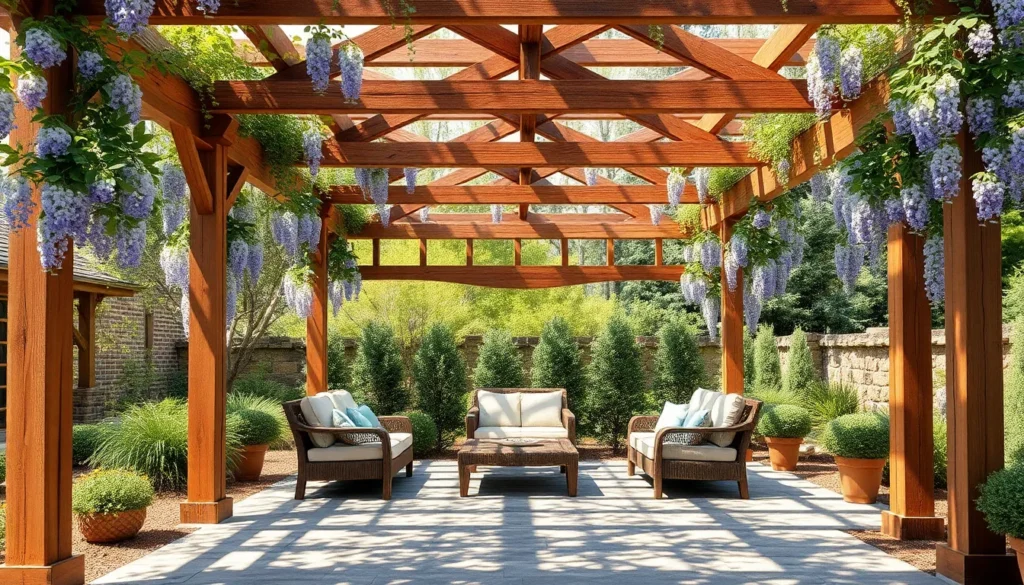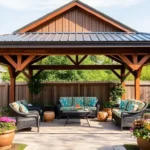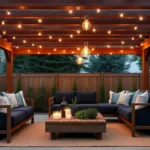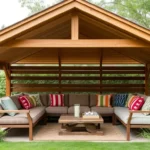Imagine stepping into a garden oasis where rustic charm and nature’s beauty seamlessly blend into a serene retreat. Whether you’re a homeowner just beginning to explore the potential of your outdoor space or a seasoned gardener looking to enhance your sanctuary, rustic pergola designs offer an enchanting canvas for creativity and relaxation. These structures not only provide shelter and shade but also become the centerpiece of a garden that invites tranquility and connection with the natural world.
In this article, we’ll unravel the timeless appeal of rustic pergolas, guiding you through design choices that harmonize with the organic textures of your garden. From selecting the right materials to incorporating climbing plants that weave a tapestry of greenery, you’ll discover practical tips and inspiring ideas to transform your outdoor area into a personalized haven. Embrace the journey of enhancing your garden with a pergola that reflects your unique style, and let your outdoor living space become a cherished extension of your home.
Choosing Materials for Rustic Pergolas

When selecting materials for your rustic pergola, consider using natural, durable options like cedar or redwood, which resist decay and insects. These woods not only blend seamlessly into garden settings but also provide strength and longevity. For beginners, opting for pre-treated wood can simplify maintenance, while experienced builders might explore reclaimed wood for a truly rustic feel.
Incorporating design elements such as rough-hewn beams and natural finishes enhances the rustic charm. To add a personalized touch, use materials like wrought iron for brackets or cross beams for additional stability and style. Be sure to follow construction guidelines, ensuring posts are at least 6×6 inches for adequate support, and use galvanized steel hardware to prevent rust and maintain structural integrity.
Incorporating Pergolas into Garden Landscapes

Incorporating pergolas into garden landscapes can transform your outdoor space into a serene retreat. Begin by selecting a location that complements both the style of your home and the natural surroundings. Ensure the pergola’s scale matches the size of your garden; for smaller spaces, a compact design with a height of about 8 feet is ideal, while larger areas may accommodate expansive structures. For beginners, using treated wood or weather-resistant materials like cedar provides durability and a rustic aesthetic. Consider adding climbing plants such as wisteria or jasmine to enhance the natural beauty and create a lush canopy over time.
To elevate the functionality of your pergola, think about integrating design elements such as built-in seating or outdoor lighting. Adding LED string lights or lanterns can create a cozy ambiance perfect for evening gatherings. For those with advanced skills, incorporating adjustable louvered roofs offers flexibility in managing sunlight and shade. When constructing, use galvanized hardware to prevent rust and ensure longevity. Anchor the pergola securely to withstand varying weather conditions, and consider using a gravel or stone base for stability and drainage. With thoughtful planning, your pergola can be a stunning and practical focal point in your garden.
Design Elements for Natural Aesthetics

To achieve a natural aesthetic with your rustic pergola, focus on using materials that blend seamlessly with the garden environment. Opt for locally sourced woods like cedar or redwood, which not only offer durability but also weather beautifully over time, enhancing the rustic charm. For a truly natural look, consider incorporating unfinished wood surfaces that allow the grain to be the star, and complement this with stone or gravel pathways to ground the structure in the landscape.
Incorporating nature into your design can be as simple as adding climbing plants and vines. Choose species such as wisteria, clematis, or grapevines to drape over the pergola, offering both shade and visual interest. For a more sophisticated touch, weave in some outdoor lighting with solar-powered lanterns or string lights, which can create an enchanting atmosphere during evening gatherings. Remember, the key is to integrate the pergola with its surroundings, making it a natural extension of your garden’s beauty.
Enhancing Garden Ambiance with Pergolas

Incorporating a pergola into your garden can significantly enhance its ambiance, providing both beauty and functionality. Opt for natural materials like cedar or reclaimed wood to seamlessly blend with the rustic aesthetic of your garden. Beginners can start with a simple rectangular design, while more experienced DIY enthusiasts might consider adding lattice work or a retractable canopy for added shade and style. Ensure that the pergola’s dimensions are proportionate to your garden space; a common guideline is to leave at least 8-10 feet of headroom for comfort.
To elevate your pergola’s visual appeal, incorporate climbing plants such as wisteria or jasmine, which add fragrance and a lush, verdant canopy. Secure the structure with concrete footings to ensure stability and durability, especially in areas prone to strong winds. For nighttime ambiance, string LED lights or lanterns along the beams to create a cozy, illuminated setting. Remember, the key is to balance aesthetics with functionality, ensuring that your pergola not only complements your garden but also serves as a welcoming retreat.
Maintenance Tips for Long-Lasting Designs

Regular maintenance is crucial for ensuring your rustic pergola remains a charming focal point in your garden for years. Begin with selecting durable materials such as cedar or redwood, which are naturally resistant to rot and pests. Annual inspections for loose joints or signs of wear will help you address small issues before they become significant problems. Consider applying a protective sealant or stain every few years to preserve the wood’s natural beauty and protect it from the elements.
Design elements like climbing plants add a natural touch but require careful management. Prune back overgrowth to prevent excess moisture from accumulating and causing damage to the wood. For more advanced designs, consider adding a slanted roof to minimize water pooling and extend the life of your pergola. Lastly, ensure the structure is securely anchored to withstand high winds, using metal brackets or concrete footings for extra stability. These steps will not only enhance the longevity of your pergola but will also keep it looking pristine.
Conclusion: Creating Beautiful Outdoor Spaces
In exploring ‘Rustic Pergola Designs for Natural Gardens,’ we delved into how these charming structures can enhance your outdoor space while strengthening your relationship with nature and each other. We discussed the importance of shared projects, the joy of creating a serene space for connection, and the benefits of open-air escapes to nurture intimacy. We also looked at how collaborating on garden designs can build teamwork and communication, and how incorporating natural elements fosters a harmonious environment.
Now, take the next step by choosing a pergola design that resonates with both of you. Head to your garden and envision the possibilities together, fostering collaboration and shared dreams. As you embark on this journey, let this article be your guide. Save or bookmark it now to ensure these insights are always within reach as you cultivate a space that mirrors the beauty of your relationship.
Remember, every pergola you build is a testament to your partnership’s growth. By investing in these shared experiences, you’re setting the foundation for a flourishing future. Together, let’s build not just gardens, but thriving relationships that stand the test of time.






